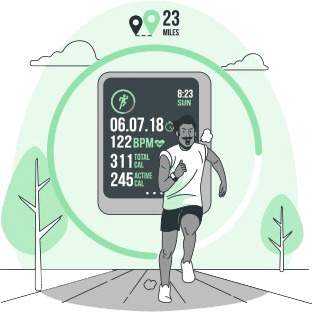
How to Make Profits with Fitness and Nutrition App
Are you planning to build a fitness app?
Well, this is the right time. Healthy lifestyles have become mainstream. People are now more reluctant to use a fitness and nutrition app to track their health. If we look at the numbers, it says that in 2022, there will be 86.3 million users of health and fitness apps in the US alone.
But, do you have a strategy to compete with 400,000+ health and fitness apps available on the Google app store alone? One tried and tested way is to build a niche-specific app – fitness tracking, workout, nutrition, and diet, etc. You can then categorize it based on your target audience – you can target a specific location and the development platform. For example, an iOS nutrition app specifically for the US location.
(Did you know that iOS accounted for 52.6% of the revenue share of fitness apps in 2020?)
Now comes the most important question – how to make profits with it? This can be tricky. So, we’ve explained the most preferred monetization models in this article.
Let’s dig in!
In-app Advertising
It is the most commonly used method to generate revenue from fitness apps. Whenever a user clicks on the ad or sees one in the app, you get paid. All you have to do is offer space to other brands on your landing page or in between activities. It is easy to implement. There are numerous ad types that you can display on your app: the most common include – banner ads, interstitial ads, native ads, and affiliate ads.
Apps like MyFitnessPal and Fooducate have this monetization model to get profits.
Note: Users get annoyed with frequent ads. So, make sure that the ads are relevant and they don’t disrupt their user experience.
Paid Apps
Paid apps are the first one to join the monetization model. It works simply: businesses publish the apps on appstore. Users pay a charge to install and use it.
You can build a fitness app on any platform (Android, iOS, or both). However, you need to know that users have become savvy when it comes to looking for services and products for free. Also, there are a large number of free apps vying for user attention.
That’s when your design and features can come to the picture. If you’re planning to go for a paid model, ensure that your app design is attractive and has advanced features (like personalized recipes, virtual consultation, workout plans) that customers would be willing to pay for. Mention all the features in the Google and Apple app store catalog.
My Diet Coach-Pro is one of the best fitness apps that implemented this model. It provides power-packed features like personalized diet plans, barcode scanners, meal diaries, calorie counter, virtual rewards, and more.
Freemium
The most preferable revenue model is freemium. It is a blend of paid and free content. If you go with this model, you can allow users to download the app for free and pay for premium services. For example, you can provide free diet plans and charge them for personalized ones.
Since users prefer downloading a free app, this model can be beneficial for you. You can create a vast customer base with essential features in a short span and eventually turn them into members with exciting paid features.
The best example of this model is MyFitnessPal. It offers premium features with access to features like food analysis, nutrition dashboard, calorie goals by meal, etc.
In-app Purchases
In-app purchases help you create additional sales channels. Here you sell virtual products and services. It’s unlike freemium that provides all the premium services on purchase.
In this model, you can charge for specific products or services such as virtual consultation, personalized data plan, etc. Users can use the rest of the features, such as workouts and calorie counters, for free.
Note: This kind of model doesn’t work well with fitness and nutrition apps.
Subscription
This method resembles freemium but has a few distinct points. Here, users get access to content and not the features of the app.
Typically, some content is available for free – like tofu recipes. If users want to know more, say, non-veg diet recipes, vegan recipes, they can subscribe to it (monthly, quarterly, or yearly).
Conclusion
Don’t just decide on a monetization model because your competitor is implementing it. Or, someone says that it’s the best and helps generate more revenue.
Every monetization has its pros and cons. See what works best for you. The monetization would differ based on your target audience, location, niche, and other factors. For instance, an iOS nutrition app would have a different audience than an Android nutrition app.
Also, try mixing one or two models – a hybrid may be the right for you!
All I want to say is – experiment, explore, and don’t rely on one monetization model. Earn profits from wherever possible, keeping customer experience and satisfaction in mind.
Read more Article: https://www.trendzzzone.com
















